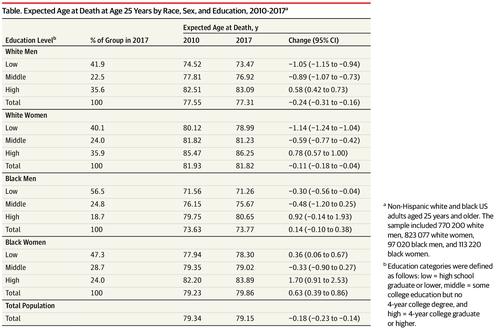Our official English website, www.x-mol.net, welcomes your
feedback! (Note: you will need to create a separate account there.)
Association Between Educational Attainment and Causes of Death Among White and Black US Adults, 2010-2017
JAMA ( IF 63.1 ) Pub Date : 2019-08-27 , DOI: 10.1001/jama.2019.11330 Isaac Sasson 1 , Mark D Hayward 2
JAMA ( IF 63.1 ) Pub Date : 2019-08-27 , DOI: 10.1001/jama.2019.11330 Isaac Sasson 1 , Mark D Hayward 2
Affiliation

|
Importance
There are substantial and increasing educational differences in US adult life expectancy. To reduce social inequalities in mortality, it is important to understand how specific causes of death have contributed to increasing educational differences in adult life expectancy in recent years. Objective
To estimate the relationship of specific causes of death with increasing educational differences in adult life expectancy from 2010 to 2017. Design, Setting, and Participants
Serial cross-sectional study of 4 690 729 deaths recorded in the US National Vital Statistics System in 2010 and 2017. Exposures
Sex, race/ethnicity, and educational attainment. Main Outcomes and Measures
Life expectancy at age 25 years and years of life lost between ages 25 and 84 years by cause of death. Results
The analysis included a total of 2 211 633 deaths in 2010 and 2 479 096 deaths in 2017. Between 2010 and 2017, life expectancy at age 25 significantly declined among white and black non-Hispanic US residents from an expected age at death of 79.34 to 79.15 years (difference, -0.18 [95% CI, -0.23 to -0.14]). Greater decreases were observed among persons with a high school degree or less (white men: -1.05 years [95% CI, -1.15 to -0.94], white women: -1.14 years [95% CI, -1.24 to -1.04], and black men: -0.30 years [95% CI, -0.56 to -0.04]). White adults with some college education but no 4-year college degree experienced similar declines in life expectancy (men: -0.89 years [95% CI, -1.07 to -0.73], women: -0.59 years [95% CI, -0.77 to -0.42]). In contrast, life expectancy at age 25 significantly increased among the college-educated (white men: 0.58 years [95% CI, 0.42 to 0.73], white women: 0.78 years [95% CI, 0.57 to 1.00], and black women: 1.70 years [95% CI, 0.91 to 2.53]). The difference between high- and low-education groups increased from 2010 to 2017, largely because life-years lost to drug use increased among those with a high school degree or less (white men: 0.93 years [95% CI, 0.90 to 0.96], white women: 0.50 years [95% CI, 0.47 to 0.52], black men: 0.75 years [95% CI, 0.71 to 0.79], and black women: 0.28 years [95% CI, 0.25 to 0.31]). Conclusions and Relevance
In this serial cross-sectional study, estimated life expectancy at age 25 years declined overall between 2010 and 2017; however, it declined among persons without a 4-year college degree and increased among college-educated persons. Much of the increasing educational differences in years of life lost may be related to deaths attributed to drug use.
中文翻译:

2010-2017 年美国白人和黑人成人教育程度与死亡原因之间的关联
重要性 在美国成年人的预期寿命中存在着巨大且不断增加的教育差异。为了减少死亡率方面的社会不平等,了解具体的死亡原因如何导致近年来成人预期寿命的教育差异越来越大是很重要的。目的 估计特定死因与 2010 年至 2017 年成人预期寿命教育差异增加的关系。 设计、设置和参与者 对 2010 年和 2017 年美国国家生命统计系统中记录的 4 690 729 例死亡的连续横断面研究2017. 暴露性别、种族/民族和教育程度。主要结果和措施 25 岁的预期寿命和 25 至 84 岁之间因死亡原因而损失的寿命。结果 分析包括 2010 年和 2017 年共有 2 211 633 人死亡和 2 479 096 人死亡。 2010 年至 2017 年间,美国白人和黑人非西班牙裔居民的 25 岁预期寿命显着下降,预期死亡年龄为 79.34至 79.15 岁(差异,-0.18 [95% CI,-0.23 至 -0.14])。在高中或以下学历的人群中观察到的下降幅度更大(白人男性:-1.05 岁 [95% CI,-1.15 至 -0.94],白人女性:-1.14 岁 [95% CI,-1.24 至 -1.04],和黑人:-0.30 岁 [95% CI,-0.56 至 -0.04])。受过一些大学教育但没有 4 年大学学位的白人成年人的预期寿命也经历了类似的下降(男性:-0.89 岁 [95% CI,-1.07 至 -0.73],女性:-0.59 岁 [95% CI,-0.77 至-0.42])。相比之下,受过大学教育的人 25 岁时的预期寿命显着增加(白人男性:0.58 岁 [95% CI,0.42 至 0.73],白人女性:0.78 岁 [95% CI,0.57 至 1.00],黑人女性:1.70 岁 [ 95% CI,0.91 至 2.53])。从 2010 年到 2017 年,高教育和低教育群体之间的差异增加,主要是因为高中或以下学历的人因吸毒而损失的生命年增加(白人男性:0.93 岁 [95% CI,0.90 至 0.96] ,白人女性:0.50 岁 [95% CI,0.47 至 0.52],黑人男性:0.75 岁 [95% CI,0.71 至 0.79],黑人女性:0.28 岁 [95% CI,0.25 至 0.31])。结论和相关性 在这项连续横断面研究中,25 岁的估计预期寿命在 2010 年至 2017 年间总体下降;然而,在没有 4 年大学学位的人群中下降,在受过大学教育的人群中增加。生命损失年数日益增加的教育差异可能与因吸毒导致的死亡有关。
更新日期:2019-08-27
中文翻译:

2010-2017 年美国白人和黑人成人教育程度与死亡原因之间的关联
重要性 在美国成年人的预期寿命中存在着巨大且不断增加的教育差异。为了减少死亡率方面的社会不平等,了解具体的死亡原因如何导致近年来成人预期寿命的教育差异越来越大是很重要的。目的 估计特定死因与 2010 年至 2017 年成人预期寿命教育差异增加的关系。 设计、设置和参与者 对 2010 年和 2017 年美国国家生命统计系统中记录的 4 690 729 例死亡的连续横断面研究2017. 暴露性别、种族/民族和教育程度。主要结果和措施 25 岁的预期寿命和 25 至 84 岁之间因死亡原因而损失的寿命。结果 分析包括 2010 年和 2017 年共有 2 211 633 人死亡和 2 479 096 人死亡。 2010 年至 2017 年间,美国白人和黑人非西班牙裔居民的 25 岁预期寿命显着下降,预期死亡年龄为 79.34至 79.15 岁(差异,-0.18 [95% CI,-0.23 至 -0.14])。在高中或以下学历的人群中观察到的下降幅度更大(白人男性:-1.05 岁 [95% CI,-1.15 至 -0.94],白人女性:-1.14 岁 [95% CI,-1.24 至 -1.04],和黑人:-0.30 岁 [95% CI,-0.56 至 -0.04])。受过一些大学教育但没有 4 年大学学位的白人成年人的预期寿命也经历了类似的下降(男性:-0.89 岁 [95% CI,-1.07 至 -0.73],女性:-0.59 岁 [95% CI,-0.77 至-0.42])。相比之下,受过大学教育的人 25 岁时的预期寿命显着增加(白人男性:0.58 岁 [95% CI,0.42 至 0.73],白人女性:0.78 岁 [95% CI,0.57 至 1.00],黑人女性:1.70 岁 [ 95% CI,0.91 至 2.53])。从 2010 年到 2017 年,高教育和低教育群体之间的差异增加,主要是因为高中或以下学历的人因吸毒而损失的生命年增加(白人男性:0.93 岁 [95% CI,0.90 至 0.96] ,白人女性:0.50 岁 [95% CI,0.47 至 0.52],黑人男性:0.75 岁 [95% CI,0.71 至 0.79],黑人女性:0.28 岁 [95% CI,0.25 至 0.31])。结论和相关性 在这项连续横断面研究中,25 岁的估计预期寿命在 2010 年至 2017 年间总体下降;然而,在没有 4 年大学学位的人群中下降,在受过大学教育的人群中增加。生命损失年数日益增加的教育差异可能与因吸毒导致的死亡有关。











































 京公网安备 11010802027423号
京公网安备 11010802027423号